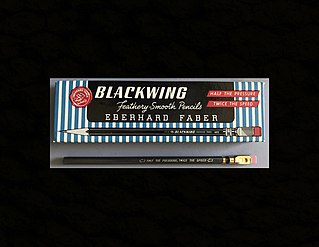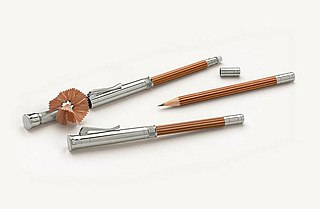
A pencil is a writing or drawing implement with a solid pigment core in a protective casing that reduces the risk of core breakage, and keeps it from marking the user's hand.

Sean Malone was an American musician who played primarily fretless bass guitar and Chapman Stick. He was most famous for his work with progressive metal band Cynic, in which he developed a strong partnership with the drummer Sean Reinert. Malone and Reinert played on several records together outside Cynic, making them one of the most favorable modern progressive rhythm sections. Malone also did a number of session jobs for various bands and musicians.
The Eberhard Faber Pencil Company was started by John Eberhard Faber in 1861 in Midtown Manhattan, New York City, by the East River at the foot of 42nd Street, on the present site of the United Nations Headquarters. After an 1872 fire, operations moved to the Eberhard Faber Pencil Factory in Greenpoint, Brooklyn, across the East River, which was acquired by Staedtler, a stationery company with global presence, in 1978. This factory was acquired by Faber-Castell USA in 1994 before being bought by Newell (Sanford) and eventually rolled into the Paper Mate brand.

The House of Castell is a German noble family of mediatised counts of the old Holy Roman Empire. In 1901, the heads of the two family branches, Castell-Castell and Castell-Rüdenhausen, were each granted the hereditary title of Prince by Luitpold, Prince Regent of Bavaria.

Staedtler SE is a German multinational stationery manufacturing company based in Nuremberg. The firm was founded by J.S. Staedtler (1800–1872) in 1835 and produces a large variety of stationery products, such as writing implements, art materials, and office supplies.
The Schwan-Stabilo Group is a German corporate group based in Heroldsberg. Established in 1855, the company is made up of two private manufacturing companies, "Schwan Cosmetics International GmbH" and "Stabilo International GmbH".

Rotring is a manufacturer of technical drawing tools and writing implements. Established in Germany in 1928 as a fountain pen manufacturer, Rotring went on to be acquired by Newell Brands in 1998. The name "Rotring" directly translates to "red ring", which refers to the company's signature: a red band placed around the barrel of the pen. The company's name was changed to Rotring in the early 1970s to match the trademark.

Stein is a town in the district of Fürth, in Bavaria, Germany. It is situated 7 km south of Fürth, and 7 km southwest of Nuremberg (centre).
Uni-ball and Uni are brands of pens and pencils, made by the Mitsubishi Pencil Company Limited of Japan. The brand was introduced in 1979 as a rollerball pen model, then expanding to the rest of Mitsubishi Pencil products.

The Blackwing 602 is a pencil that is noted for its soft, dark graphite, unique flat square ferrule and replaceable eraser. It was manufactured by the Eberhard Faber Pencil Company from 1934 to 1988, then by the Faber-Castell pencil company from 1988 to 1994 and by Sanford from 1994 to 1998. The pencil initially sold for 50 cents each. After it was discontinued single original pencils were found on eBay for over $40, with some older ones being sold for over $100. Originals are becoming increasingly rare. As of 2012 a different pencil using the same name is being manufactured by Palomino.

Graf von Faber-Castell is a brand of fine writing instruments from the German stationery manufacturer Faber-Castell. It includes a line of pencils, mechanical pencils, fountain pens, and rollerball pens. Currently, the Graf von Faber-Castell line includes high end writing instruments made with luxury materials such as ebony, resin, and ivory.

A colored pencil, coloured pencil, map pencil, pencil crayon, or coloured/colouring lead is an art medium constructed of a narrow, pigmented core encased in a wooden cylindrical case. Unlike graphite and charcoal pencils, colored pencils' cores are wax- or oil-based and contain varying proportions of pigments, additives, and binding agents. Water-soluble (watercolor) pencils and pastel pencils are also manufactured as well as colored cores for mechanical pencils.
Kaspar Faber was a German entrepreneur. He was the founder of the well-known stationery company now known as Faber-Castell.

Johann Lothar Freiherr von Faber was a German industrialist. He inherited the pencil company Faber-Castell in 1839 after the death of his father, Georg Leonhard von Faber. Under his leadership, the company gained access to new sources of raw materials and expanded internationally. Von Faber also played an important role in the introduction of trademark protection in Germany; his 1874 petition to the German Reichstag for such legislation contributed to the Act on Trade Mark Protection, passed the following year.
Patrick Alexander Hubertus Count of Faber-Castell also Patrick Graf von Faber-Castell is a German businessman and socialite.

The House of Faber-Castell, originating from Stein near Nuremberg, Germany, is the name of an entrepreneurial noble family, morganatic branch of the House of Castell-Rüdenhausen, which founded the Faber-Castell AG in 1761 and the Nürnberger Versicherung in 1884. A.W. Faber, the original name of the company, is the oldest company brand in the USA.
Caroline Gotzens (born August 20, 1961 in Stein near Nuremberg as Caroline Elisabeth Renate Ottilie Gräfin von Faber-Castell is an aristocratic German-Swiss industrial heiress. She is a family member of the Cologne-based banking dynasty Oppenheim, as well as of the Frankish pencil dynasty Faber-Castell.
Hubertus Alexander Wolfgang Rüdiger Emanuel Wilhelm Count von Faber-Castell
Anton-Wolfgang "Toni" Lothar Andreas Graf von Faber-Castell was a German entrepreneur and member of the Faber-Castell industrial and noble family. He was the eighth-generation chairman of the board of the stationery manufacturer Faber-Castell for nearly 40 years.



















